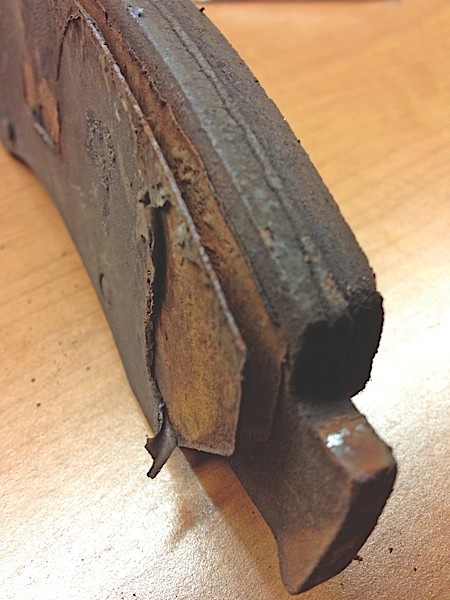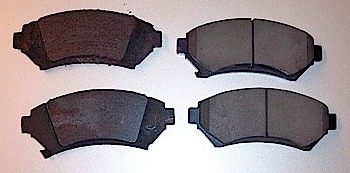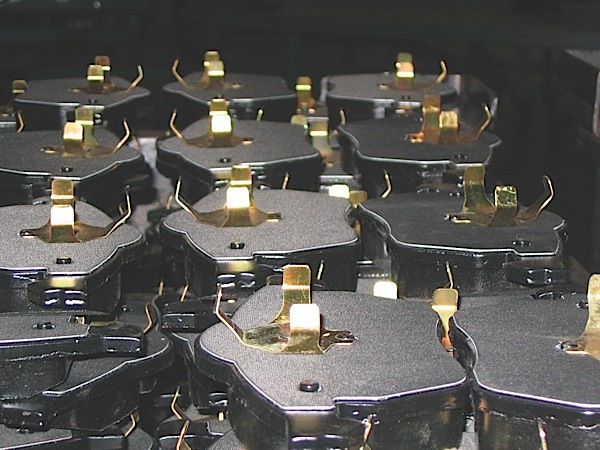CERAMIC
Ceramic material’s structural properties are very stable under high temperatures, much like Corning cookware. But this is where the comparison ends. Ceramic materials that go into a brake pad are very small strands that are engineered to be a certain length and width.
There are three advantages of ceramic pads in certain applications. First, since the ceramic materials offer stable performance under a wide range of temperatures, they can offer quiet performance. Second, ceramic brake pads manage heat in the caliper better on some vehicles than some non-ceramic applications. Third, ceramic brake dust does not show up on or stick to wheels like some other brake pad formulations. This could be an important factor if you have an expensive set of custom wheels.
NAO
Non-asbestos organic (NAO) friction materials typically wear more than harder semi-metallic compounds. It’s hard to generalize about the wear characteristics of NAO and ceramic-based compounds because there are so many. Wear varies depending on the formula the friction supplier chooses for a particular application. Different vehicles require different coefficients of friction, so formulas are often “application engineered” to deliver the best combination of stopping power, wear resistance, pedal feel and noise control. Most premium-quality NAO and ceramic-based linings will provide long life and wear less than an equivalent set of NAO pads on the same application.
SEMI-METALLIC
Semi-Metallic pads use metal fibers to give structure and provide friction. The metals used are typically high-quality steel, copper and other exotic metals.
So what is the other part of the semi-metallic mix? It is a variety of materials like glues, lubricants and structural fibers. The manufacturer will blend the components together to give the best performance for that application.
APPLICATION/VEHICLE SPECIFIC LINES
If all of the material jargon is too much to deal with, you can look for a line that touts itself as vehicle or application specific. These lines can help you leave the material selection up to the manufacturer.
What makes one friction material quieter or better than another? It is a two-part answer. First, if a friction material is better at keeping a constant coefficient of friction across broad temperature ranges and environmental conditions, it probably is a quiet pad. A “consistent” friction material causes less vibrational excitation variation at the friction coupling by having consistent brake torque at environmental extremes of humidity and temperature (-40 F to 500 F).
Second, some friction materials leave or transfer a layer of friction material (transfer film or “seasoning”) on the rotor’s surface that some friction material companies claim can smooth out the rotor surface, thereby causing less excitation and noise at the friction coupling. Also, this transfer layer may not be as sensitive to heat-induced brake torque variation.
TO THE NAKED EYE
After you have ordered the brake pad and it has been delivered, you can now inspect it with the naked eye. Packaging of the pads can be an indication of the quality. But don’t judge a book by its cover. Some of the best pads come in small boxes. This is done to reduce packaging costs and the impact to the environment. Look at the quality of the finish, shim materials and finish. Look at the overall finish of the pad. Many manufacturers will use a high-quality paint or coating on their pads. This coating is designed to resist corrosion and hopefully can survive high temperatures. The finish should not easily scratch off.
Some friction material companies are playing a game of one-up-man-ship when it comes to what they put in the box. Typically, brake pad companies will include a hardware that includes abutment and anti-rattle clips. Some might even include new caliper bolts and guide pin boots if required. Some have even have included the torque specs on the box.
BACKING PLATES

The backing plate creates a foundation for the friction material that must be stiff and stable. If a backing plate is flexing, the friction material is not in full contact with the rotor. This can cause longer stops, a softer brake pedal, and it increases the potential for unwanted noise.
Look at the thickness of the backing plate and the edges. A poorly stamped backing plate will have rough edges. Also, look at the areas where the pad contacts the caliper. These areas should be as smooth as possible.
The attachment method of friction to the backing plate does matter. For some fleet and safety-critical applications like school buses, the manufacturer or insurance company may specify a brake pad that uses a mechanical attachment to secure the friction material to the backing plate. Mechanical attachment involves some type of protrusion from the backing plate to hold the friction material. Some backing plates have tiny hooks machined into the surface to hold the material.

FRICTION SHAPE
Another aspect to look at is the shape of the friction material on the brake pad. OEMs tune the shape of the brake pad to the overall system. This includes elements like overall length and width, and design elements like chamfers and slots. These physical dimensions and design elements can reduce excitation and shift natural vibrational frequencies. Some aftermarket brake pad manufacturers will tune the shape of their pads to suit older vehicles and the characteristics of their friction material blend.
SHIMS

Look at the shim material on the back of the pad. If possible, remove the shim and drop it gently on a hard surface. If the shim makes a nice “thunk,” it is made of a good material. If the pad makes a rattling sound, like a dropped wrench, chances are it will not make a good sound insulator.
Brake shims are not designed for adjusting spacing/distance between friction material and the rotor. Shims provide multifunction noise control as a component attached to the friction pad backing plate. A quality brake shim can prevent brake noise during the entire life of the brake job and will not dry out or be displaced over time like some lubricants. But remember, a shim does not do its job if it is left in the box.
THE UNSEEN ASPECTS
When you are buying a brake pad, you are also buying the engineering and research behind it. When an aftermarket brake pad manufacturer is developing or reverse engineering an application, rarely do they test on an actual vehicle. This type of testing is expensive and time consuming.
Also, the human element can change the results. A brake dynamometer can test brake systems in a controlled environment that mirrors the real world. A brake dynamometer can run 24 hours a day and can measure the performance of a braking system over its entire lifetime. Plus, would you want to be a brake pad guinea pig for 25,000 miles?
A brake dynamometer can be more sophisticated and larger than an engine dynamometer. Brake dynamometers can simulate the conditions the brake system will experience in a much shorter time. This means that a brake dynamometer can simulate the mass, inertia and performance capabilities of a vehicle.
The typical brake dynamometer can cost anywhere between $250,000 (used) to more than $1 million. Some brake friction suppliers own dynamometers, while some lease dynamometers from testing companies.
In the engineering world, there is a saying that goes: “One test is worth a thousand expert opinions.” This saying is also true for the brake technician.










